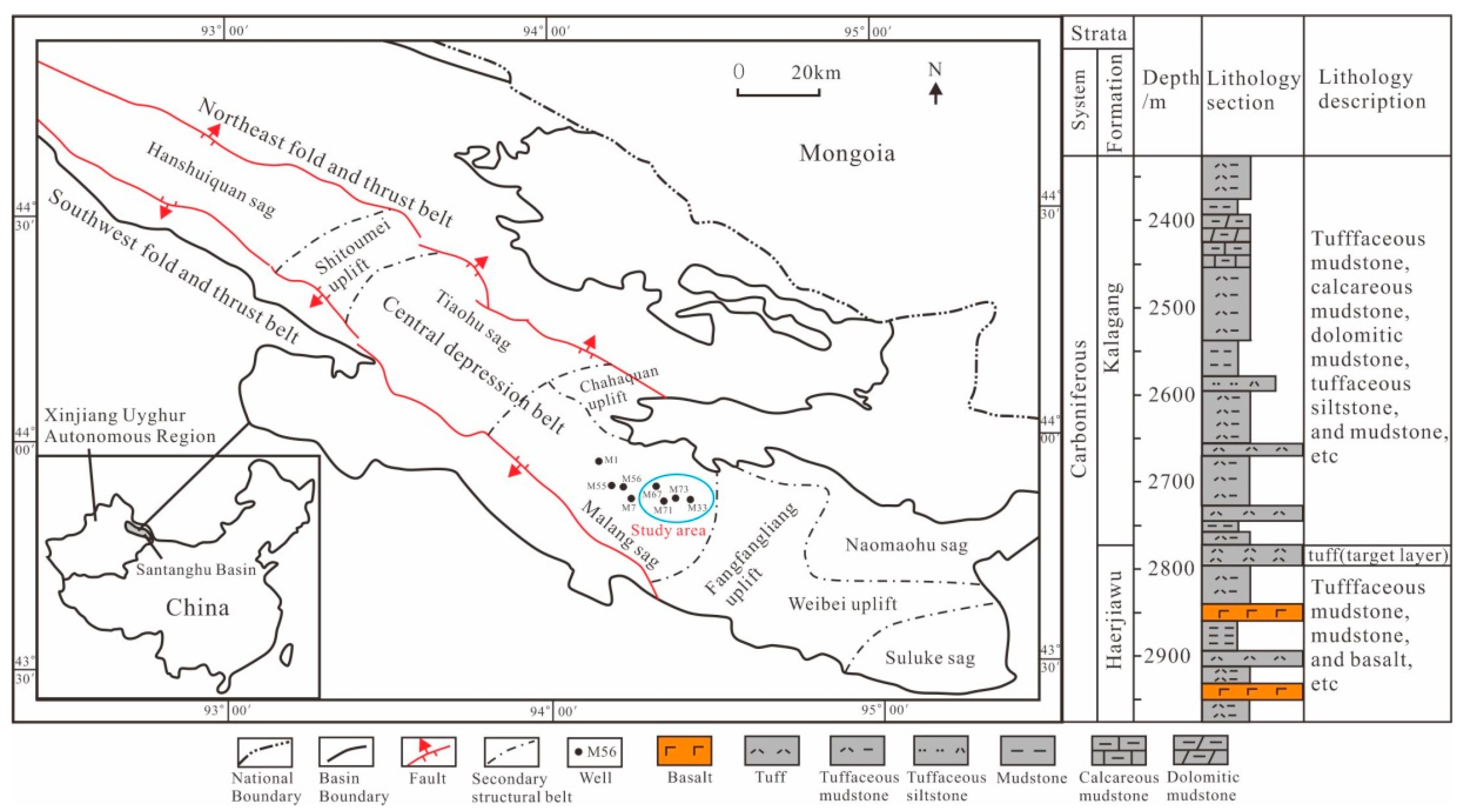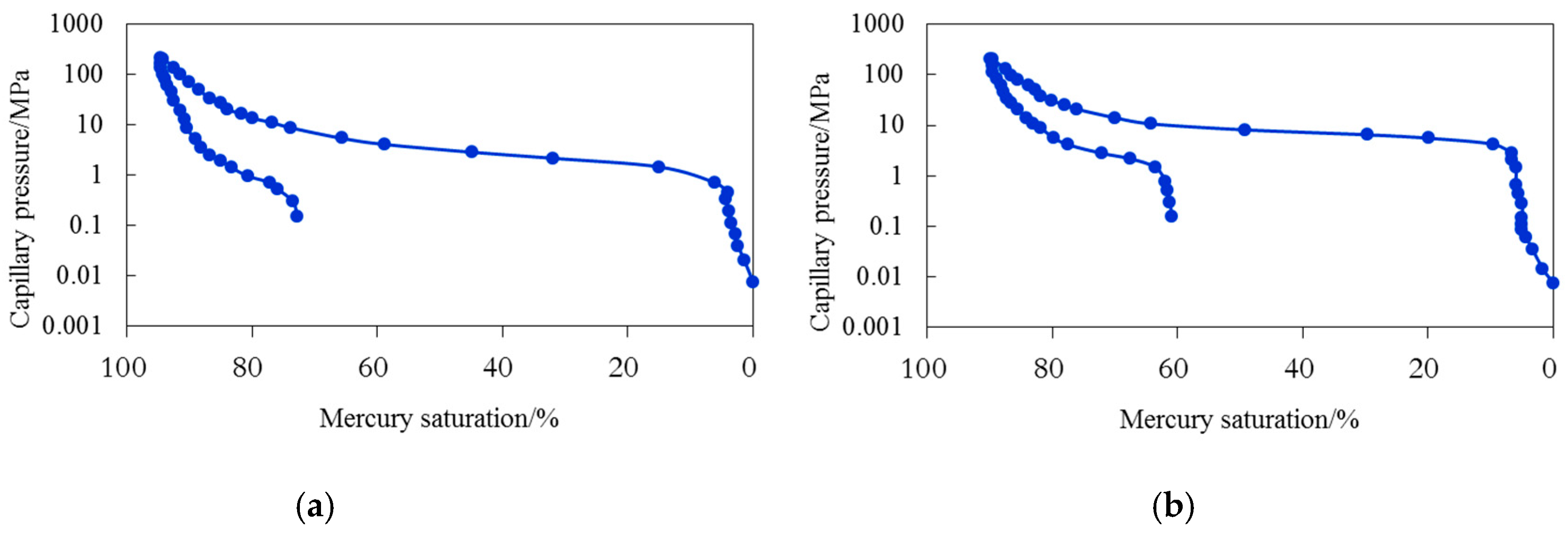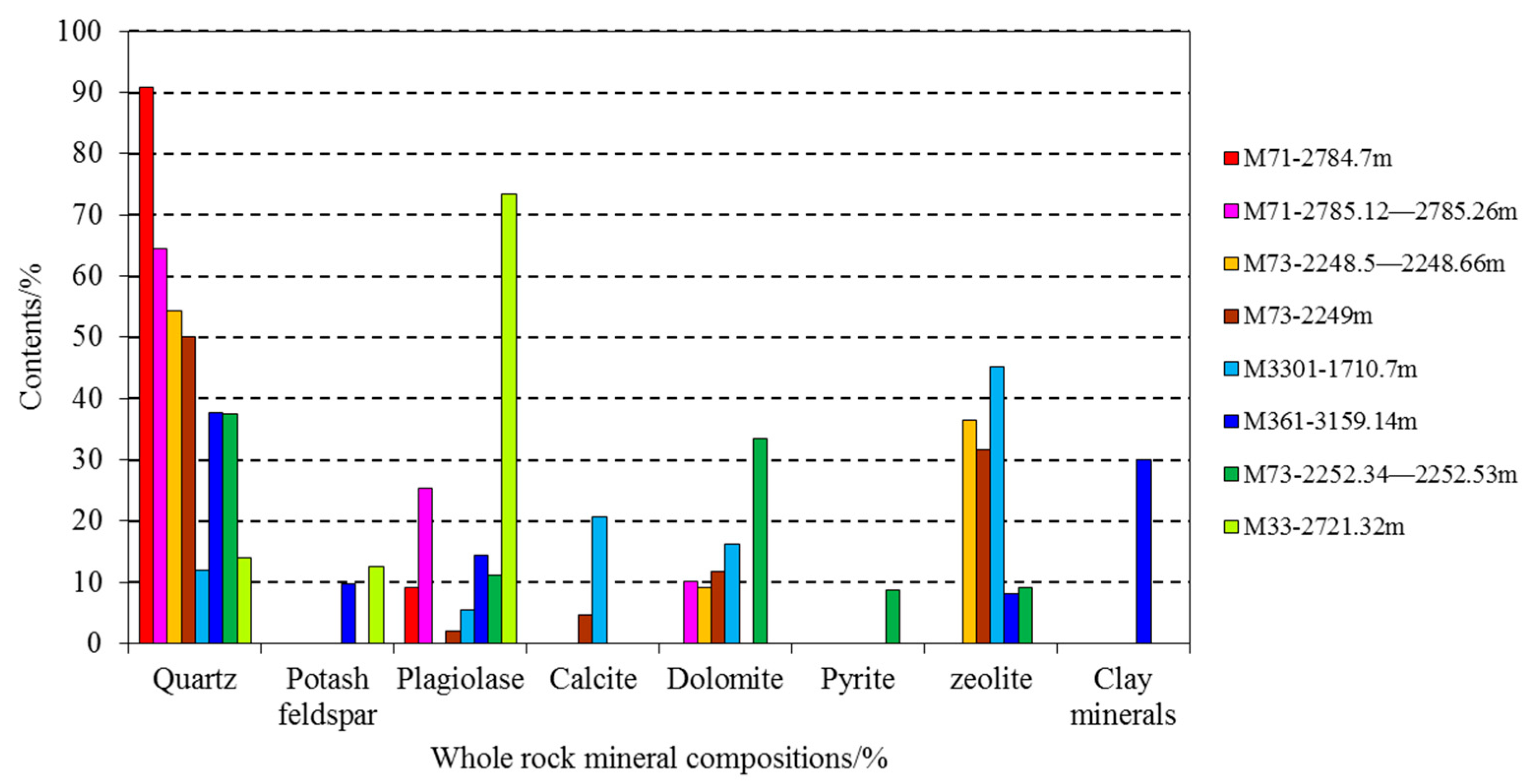The Micropore Characteristics and Geological Significance of a Tuffaceous Tight Reservoir Formed by Burial Dissolution: A Case Study of the Carboniferous Tuff in the Santanghu Basin, NW China
Abstract
:1. Introduction
2. Geological Setting
3. The Samples and Method
4. Reservoir Space of the Tuffaceous Tight Reservoir Formed by Burial Dissolution
4.1. Micropore Types and Characteristics
4.2. Micropore Structure and Reservoir Physical Properties
5. Discussion
5.1. Cause of the Formation of Micropores in Tuff
5.2. Geological Significance of the Micropores in the Tuffaceous Tight Reservoir Formed by Burial Dissolution
6. Conclusions
Author Contributions
Funding
Data Availability Statement
Conflicts of Interest
References
- Kőniger, S.; Lorenz, V.; Stollhofen, H.; Armstrong, R.A. Origin, age and stratigraphic significance of distal fallout ash tuffs from the Carboniferous-Permian continental Saar-Nahe basin (SW Germany). Int. J. Earth Sci. 2002, 91, 341–356. [Google Scholar] [CrossRef]
- Huff, W.D. Ordovician K-bentonites: Issues in interpreting and correlating ancient tephras. Quat. Int. 2008, 178, 276–287. [Google Scholar] [CrossRef]
- Qiu, X.; Liu, C.; Mao, G.; Deng, Y.; Wang, F.; Wang, J. Late Triassic tuff intervals in the Ordos basin, Central China: Their depositional, petrographic, geochemical characteristics and regional implications. J. Asian Earth Sci. 2014, 80, 148–160. [Google Scholar] [CrossRef]
- Ma, J.; Liu, G.; Huang, Z.; Ou, G.; Li, T.; Guo, X. Tight tuff reservoir characteristics and its controlling factors: A comparative study of the Permian Tiaohu Formation and Carboniferous Haerjiawu Formation in the Santanghu Basin, NW China. J. Pet. Sci. Eng. 2020, 187, 106808. [Google Scholar] [CrossRef]
- Zheng, J.; Wang, Z.; Yang, H.; Sun, C.; Zhang, Y.; Chen, J. Buried Karstification Period and Contribution to Reservoirs of Ordovician Yingshan Formation in Tazhong Area. Geoscience 2015, 29, 665–674. [Google Scholar]
- Pan, Y.; Huang, Z.; Li, T.; Xu, X.; Guo, X.; Wang, R.; Zheng, H.; Zhang, W. Study on the origin and hydrocarbon generation potential of lacustrine organic-rich dolomite affected by volcanism: A case study of Lucaogou Formation in the Malang Sag, Santanghu Basin, Western China. Mar. Pet. Geol. 2022, 141, 105699. [Google Scholar] [CrossRef]
- Pan, Y.; Huang, Z.; Guo, X.; Li, T.; Zhao, J.; Li, Z.; Qu, T.; Wang, B.; Fan, T.; Xu, X. Lithofacies types, reservoir characteristics, and hydrocarbon potential of the lacustrine organic-rich fine-grained rocks affected by tephra of the Permian Lucaogou formation, Santanghu basin, western China. J. Pet. Sci. Eng. 2022, 208, 109631. [Google Scholar] [CrossRef]
- Yan, L.; Zhou, X.; Gao, T.; Li, W. The secondary dissolution pores in volcanic reservoirs of Xingcheng Development area in Xushen Gas Field. Nat. Gas Ind. 2007, 27, 16–19. [Google Scholar]
- Croizé, D.; Ehrenberg, S.N.; Bjørlykke, K.; Renard, F.; Jahren, J. Petrophysical properties of bioclastic platform carbonates: Implications for porosity controls during burial. Mar. Pet. Geol. 2010, 27, 1765–1774. [Google Scholar] [CrossRef]
- Meng, Y.; Zhu, H.; Li, X.; Wu, C.; Hu, A.; Zhao, Z.; Zhang, L.; Xu, C. Thermodynamic analyses of dolomite dissolution and prediction of the secondary porosity zones: A case study of tight tuffaceous dolomites of the second member, Permian Lucaogou Formation reservoir, Santanghu Basin, NW China. Pet. Explor. Dev. 2014, 41, 754–760. [Google Scholar] [CrossRef]
- Li, Q.; Li, Q. Diagenesis and its effects on the reservoir of Leikoupo Formation in Longmendong area of southwestern Sichuan. Sci. Technol. Eng. 2019, 19, 103–112. [Google Scholar]
- Liu, W.; Huang, Q.; Bai, Y.; Shi, S. Meteoric water dissolution controls on microbial carbonate reservoir formation in the penecontemporaneous stage: Insight from the Lower Cambrian formation of the Tarim Basin. Earth Sci. Front. 2021, 28, 225–234. [Google Scholar]
- Yang, T.; He, Z.; Jin, Z.; Zhang, J.; Li, S. Pore structure and controlling factors of the ultra-deep Middle Permian dolomite reservoirs, northwestern Sichuan Basin. Oil Gas Geol. 2020, 41, 116–131. [Google Scholar]
- Ma, Y.; He, Z.; Zhao, P.; Zhu, H.; Han, J.; You, D.; Zhang, J. A new progress in formation mechanism of deep and ultra-deep carbonate reservoir. Acta Pet. Sin. 2019, 40, 1415–1425. [Google Scholar]
- Wang, R.; Chang, Q.; Qian, Y.; Liu, G.; Wan, M.; Huang, L. Reservoir characteristics and genesis of shale oil “sweet spots” in Lucaogou Formation, Jimsar Sag, Junggar Basin. Pet. Geol. Exp. 2020, 42, 604–611. [Google Scholar]
- Lei, H.; Huang, W.; Yi, S.; Wang, Y. Dissolution characteristics of deep-buried dolostone in the Member 5 of Ordovician Majiagou Formation in southern Ordos Basin. J. Palaeogeogr. 2020, 22, 1041–1052. [Google Scholar]
- Fan, T. Characteristics and Genesis of Pores in Volcanic Reservoirs of Haerjiawu Formation in Santanghu Basin. Xinjiang Pet. Geol. 2020, 41, 658–665. [Google Scholar]
- Pan, Y.; Huang, Z.; Guo, X.; Li, T.; Fan, T.; Xu, X. Analysis of accumulation conditions of lacustrine organic-rich shale oil affected by volcanic ash: A case study of the Lucaogou Formation in the Tiaohu Malang Sag, Santanghu Basin. Acta Geol. Sin. 2022, 96, 1053–1068. [Google Scholar]
- Chen, X.; Liu, X.Q.; Wang, X.C.; Ma, Q.; Liu, J.T.; Gong, X.; Yang, X.D.; Shi, J.F.; Bai, G.J. Formation mechanism and distribution characteristics of Lucaogou shale oil reservoir in Santanghu Basin. Nat. Gas Geosci. 2019, 30, 1180–1189. [Google Scholar]
- Liu, G.; Liu, B.; Huang, Z.; Chen, Z.; Jiang, Z.; Guo, X.; Li, T.; Chen, L. Hydrocarbon distribution pattern and logging identification in lacustrine fine-grained sedimentary rocks of the Permian Lucaogou Formation from the Santanghu basin. Fuel 2018, 222, 207–231. [Google Scholar] [CrossRef]
- Ma, J.; Ou, G.; Huang, Z. Accumulation characteristics of the Carboniferous tuff tight oil formed by burial dissolution in the Santanghu Basin. Sci. Technol. Eng. 2022, 22, 15904–15912. [Google Scholar]
- Loucks, R.G.; Reed, R.M.; Ruppel, S.C.; Hammes, U. Spectrum of pore types and networks in mudrocks and a descriptive classification for matrix-related mudrock pores. AAPG Bull. 2012, 96, 1071–1098. [Google Scholar] [CrossRef]
- Guo, X.J.; Xia, D.L.; Pang, W.; Wu, S.H.; Zou, M.; Wang, J.; Fu, Y.P. Significance of Microscope Pore Structure Characterization for Classification of Tight Reservoir: Taking the 8th Member of Yanchang Formation in Honghe Oilfield as an Example. Sci. Technol. Eng. 2019, 19, 129–136. [Google Scholar]
- Wang, J.; Xiao, D.; Lu, S.; Kong, X.; Fan, Q. Classification evaluation of shale oil reservoir physical properties in Lucaogou Formation, Jimsar Sag. J. China Univ. Min. Technol. 2020, 49, 172–183. [Google Scholar]
- Kirov, G.; Šamajova, E.; Nedialkov, R.; Stanimirova, T. Alteration processes and products of acid pyroclastic rocks in Bulgaria and Slovakia. Clay Miner. 2011, 46, 279–294. [Google Scholar] [CrossRef]
- McHenry, L.J. Element mobility during zeolitic and argillic alteration of volcanic ash in a closed-basin lacustrine environment: Case study Olduvai Gorge, Tanzania. Chem. Geol. 2009, 265, 540–552. [Google Scholar] [CrossRef]
- Meng, Y.; Hu, A.; Qiao, D.; Xie, X.; Pan, X.; Wang, J.; Tian, W. Regional diagenetic law and control of diagenesis over gas-bearing capacity of tight reservoirs in deep Xujiaweizi Fault Depression, Songliao Basin. Acta Geol. Sin. 2012, 86, 325–334. [Google Scholar]
- Zhang, L.; Ji, Y.; Liu, L.; Meng, Q.; Zhao, L.; Yu, M.; Zhou, B. Diagenetic evolution and controlling factors of pyroclastic reservoirs of the Lower Cretaceous in Nanbeier Sag, Hailar-Tamtsag Basin. J. Palaeogeogr. 2013, 15, 261–274. [Google Scholar]
- Jiang, K.; He, W.; Peng, L.; Chen, Z.; Zhu, J.; Xiang, N. Burial dissolution of Zhujiang reef limestone on the Liuhua carbonate platform, South China Sea. Mar. Geol. Quat. Geol. 2015, 35, 61–71. [Google Scholar]
- Hu, M.; Cai, X.; Hu, Z.; Qian, Y.; Xiang, J. Deep buried dissolution of Ordovician carbonates in Tazhong area of Tarim Basin. J. Oil Gas Technol. 2009, 31, 49–54. [Google Scholar]






Disclaimer/Publisher’s Note: The statements, opinions and data contained in all publications are solely those of the individual author(s) and contributor(s) and not of MDPI and/or the editor(s). MDPI and/or the editor(s) disclaim responsibility for any injury to people or property resulting from any ideas, methods, instructions or products referred to in the content. |
© 2024 by the authors. Licensee MDPI, Basel, Switzerland. This article is an open access article distributed under the terms and conditions of the Creative Commons Attribution (CC BY) license (https://creativecommons.org/licenses/by/4.0/).
Share and Cite
Ma, J.; Pan, Y.; Tong, Z.; Zhang, G. The Micropore Characteristics and Geological Significance of a Tuffaceous Tight Reservoir Formed by Burial Dissolution: A Case Study of the Carboniferous Tuff in the Santanghu Basin, NW China. Processes 2024, 12, 1514. https://doi.org/10.3390/pr12071514
Ma J, Pan Y, Tong Z, Zhang G. The Micropore Characteristics and Geological Significance of a Tuffaceous Tight Reservoir Formed by Burial Dissolution: A Case Study of the Carboniferous Tuff in the Santanghu Basin, NW China. Processes. 2024; 12(7):1514. https://doi.org/10.3390/pr12071514
Chicago/Turabian StyleMa, Jian, Yongshuai Pan, Zhongzheng Tong, and Guoqiang Zhang. 2024. "The Micropore Characteristics and Geological Significance of a Tuffaceous Tight Reservoir Formed by Burial Dissolution: A Case Study of the Carboniferous Tuff in the Santanghu Basin, NW China" Processes 12, no. 7: 1514. https://doi.org/10.3390/pr12071514




